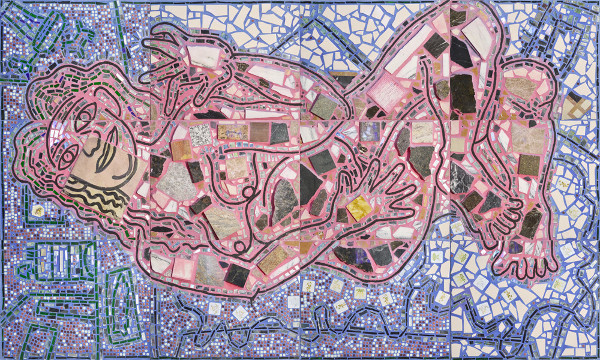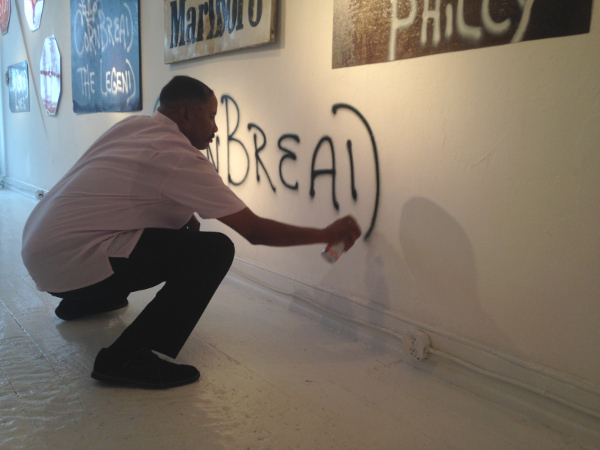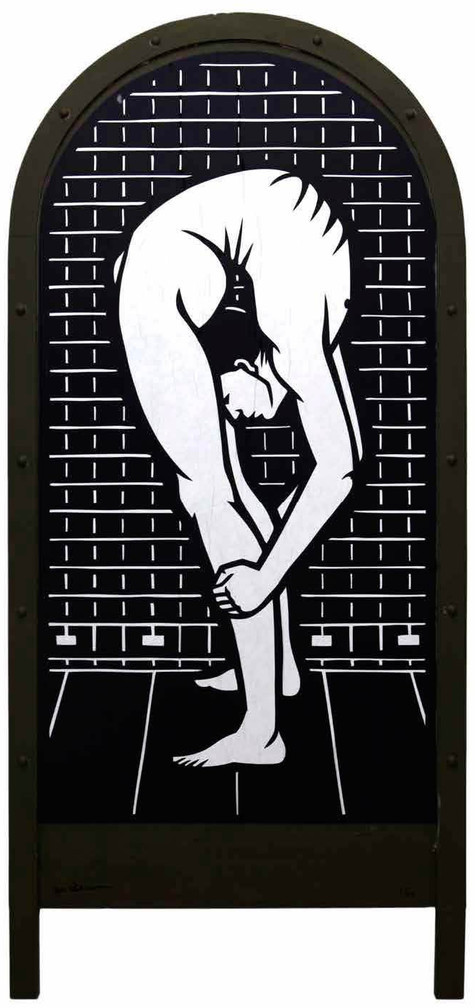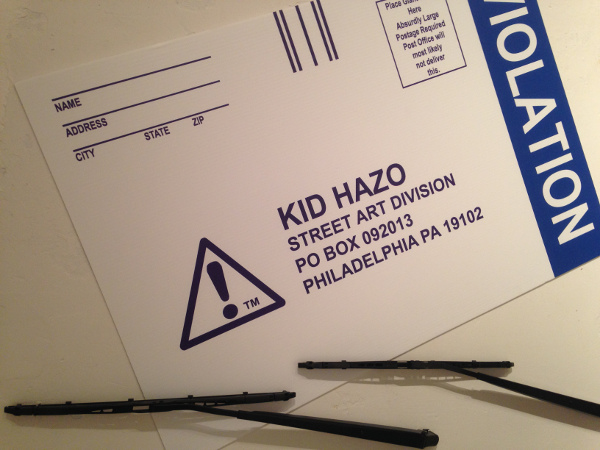
Street art from Cornbread to conceptual at James Oliver Gallery
Without a doubt, when street art becomes the topic of conversation, it is impossible to ignore the effect Philadelphia has had on public pieces of expression. From the earliest days of modern graffiti to the current scene of old and new muralists and mosaic-makers, Philly consistently tops the list of cities with outdoor art for all. “I Am Here,” the current exhibit at James Oliver Gallery, curated by Sara McCorriston of Paradigm Gallery + Studio, offers a sampler of street art essentials to both the knowledgeable and novices alike.
Any stroll around South Philly reveals pieced-together assemblages of tile, bottles, stone, glass, trinkets and all manner of colors and textures. For those familiar with these mélanges and the Philadelphia Magic Gardens, Isaiah Zagar is the man behind the mosaics. What surely started as a personal hobby has turned into an institution, and Zagar’s works have come to define the neighborhoods in which they seemingly tumble down the walls and sometimes across the sidewalks. His inclusion to the show is a 12-panel, 72×120 inch representation of a nude, pink woman lying down amidst a blue field and broken bits of mirror. The wavy lines and fragments clash and twist from section to section, forming a gigantic figurative feature at the heart of the gallery.
Darryl “Cornbread” McCray tagging the James Oliver Gallery wall. Image courtesy Sara McCorriston
For those familiar with the history of graffiti, the inclusion of pieces by Darryl “Cornbread” McCray is an especially worthy counterpoint to Zagar’s work. Credited with being the first modern graffiti artist, Cornbread began scrawling his nickname on walls throughout the city in the ’60s. This process of ‘tagging’ eventually made its way to New York City, where it gave rise to the beginnings of current graffiti. A wall dedicated to his seminal tags includes spray-painted signatures and symbols like crowns on sheet metal, stop signs, Marlboro ads, and – obviously – directly on the wall.
Joe Boruchow, “Animal Locomotion.” Image courtesy Paradigm Studio + Gallery
Black and white patterns, bodies, structures and even epitaphs find their homes on walls and mailboxes in just about every corner of Philadelphia courtesy of Joe Boruchow’s unmistakable cut paper wheat pastes. A man bent almost completely in half for “Animal Locomotion” tends to prove the antithesis of its title, stopping passersby in their tracks to check out the bizarre rendition, while “Momento Mori” depicts a tombstone in remembrance of the artist himself. Not only is Boruchow not dead, but his prolific output proves he’s probably closer to superhuman.
Kid Hazo, “The Big Payback.” Image courtesy Sara McCorriston
The show also skews slightly more conceptual with the work of Kid Hazo, who provides humorous cultural commentary through his signage. A “Loading Zone” sign with the recognizable spinning cursor and “Please Wait…” caption provides a quirky re-imagining of traditional street signs. Elsewhere, Kid Hazo prints enormous (24 x 36 inch) parking tickets, which he dutifully places beneath the windshield wipers of Philadelphia Parking Authority cars, turning the tables on the ticketers.
Jessie Hemmons, aka Ishknits, offers the show a centerpiece with her yarn-bombed wooden palette, “Stacked.” Dotting the city with similar sweaters for inanimate objects like lamp posts, fences, bicycle racks and occasionally statues of ex-mayors, her softer skew clashes the typically at-home act of knitting with the visibility of public display.
Last, and certainly not least, is Conrad Benner, a.k.a. Streets Dept, whose website and social media presence champions the art of both popular and emerging street artists in and around Philly. By spending his time about town photographing and documenting the sometimes transient and always intriguing pieces that pop up wherever opportunity and inspiration overlap, we find ourselves left with a mountain of artistic vision compiled for all to revisit whenever they’d like. Benner’s wall of photos in the show prove that while the artists and art-removers are each hard at work, Streets Dept fills in the gaps by capturing the fray in real time. This resource is not to be overlooked.
From every corner of artistic creation to the documentation that keeps some of these images alive in our collective consciousness, “I Am Here” is a heavy-hitter in terms of its scope. McCorriston’s curation leaves no stone unturned in its summary of a diverse and ever-changing community of artists that either revels or hides in plain sight. The exhibition will be at James Oliver Gallery through August 2.
James Oliver Gallery is located at 723 Chestnut St. on the 4th floor, Philadelphia; [email protected]; jamesolivergallery.com.
Recent Content
-
Artsarticle ·
-
Artsarticle ·
-
Artsarticle ·




